Posts Tagged ‘Michigan State University’
Sunday, September 8th, 2013
By Carolyn Yeager

Above: Ken Waltzer’s now notorious signature photo connecting him to his claim, for years, that Elie Wiesel was in this photograph of youths from the Buchenwald children’s barracks being marched out of the camp after so-called liberation.
We have further proof that Elie Wiesel was not at Buchenwald because Prof. Ken Waltzer is still unwilling to publish his book about the “rescue of children from Buchenwald,” a book which has always included the “Nobel Laureate Elie Wiesel”among the children.
Since Waltzer is the only holocaust “historian” I know who is still on record as saying he can prove that Elie Wiesel was a prisoner at the Buchenwald concentration camp—and that his father Shlomo died there—I think that makes Waltzer a fitting subject for this website. And the 84-year old Wiesel himself is not doing anything that I can find news of these days, so I’m a little hard up for inspiration.
Thus I ask: What is Waltzer up to? Well, he has been heading a group of Michigan Jews in creating a traveling exhibition that is meant to remind Jews, and convince if necessary, of all the poisecution they experienced during the WWII years and to celebrate how extraordinarily well things have been going for Jews since (while, of course, still having to be on guard against new poisecution).
Thus, the exhibition is titled Uneasy Years: Michigan Jewry During Depression and War. Michigan Jewry! How many Jews are in Michigan? According to a Jewish website, in 2012 there were 82,270, which is 0.8% (8/10 of 1%) of the total Michigan population. But that is enough for Ken Waltzer and other Jews to build an entire traveling exhibition for.
Or could the reason really be that Waltzer, as a professor at Michigan State University, must always show that he is active and contributing scholastically in his area of expertise. Since his book on the “rescue of children at Buchenwald” continues to be in a state of “research”—after all these years—he must find other projects to work on. 1 Last year he was consultant on a Jewish film project about holocaust survivors. This year he’s got the traveling exhibition.
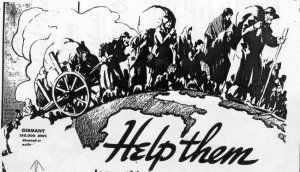 What is learned from the exhibition
What is learned from the exhibition
The 21st Century Jews of Michigan are told that in past times they had to join together to help needy fellow Jews. The message is conveyed that they still need to do so because Jews are always in need, as “anti-Semitism” is always a threat—somewhere. Hasn’t it always been so? Elie Wiesel would approve of this message! [Right: Theme image for the Allied Jewish Campaign, 1938]
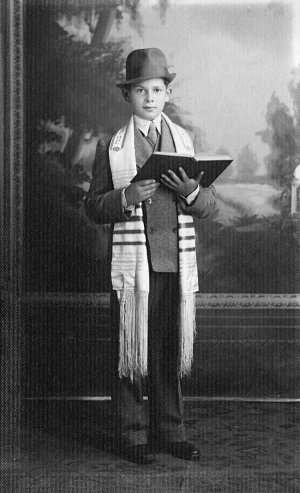 The main thing I notice about this exhibit is that it is totally, 100% about Jews and specifically Jewish concerns. The few non-Jews mentioned are enemies of the Jews. While it starts out saying that by the 1930’s Jews were increasingly comfortable with American ways, it shows nothing about Jews integrating socially with American gentiles and Christians, but only sticking closely with their own kind, their own organizations, their synagogues and businesses. Jews want to be accepted by the majority Gentile culture as “just like them,” but they do not want to participate in the majority Gentile culture, except politically and financially. [Left: Bar Mitzveh Day for Harry Klein]
The main thing I notice about this exhibit is that it is totally, 100% about Jews and specifically Jewish concerns. The few non-Jews mentioned are enemies of the Jews. While it starts out saying that by the 1930’s Jews were increasingly comfortable with American ways, it shows nothing about Jews integrating socially with American gentiles and Christians, but only sticking closely with their own kind, their own organizations, their synagogues and businesses. Jews want to be accepted by the majority Gentile culture as “just like them,” but they do not want to participate in the majority Gentile culture, except politically and financially. [Left: Bar Mitzveh Day for Harry Klein]
It tells us that Michigan Jews were terribly affected by the war in Europe—the spread of Nazism in Europe brought rising “anti-Semitism” in the U.S, and Michigan was not spared! Evil people like Catholic priest Father Charles Coughlin were openly “anti-Semitic” and 30 million non-Jewish Americans listened to his weekly radio broadcasts. [Shown at right speaking over WJR radio in the 1930s] The exhibit particularly excoriates Father Coughlin simply because he warned about excessive power of the Jews. The exhibit shows that Life and Time magazines, and the powerful Detroit Free Press were all on the side of the Jews against Father Coughlin … so where was the problem? Are we dealing with a real threat or with some kind of Jewish agenda here?
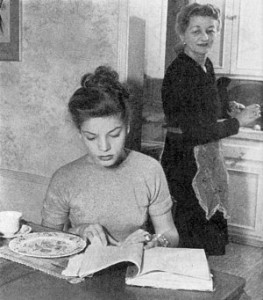
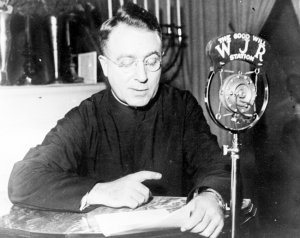
At the same time, Jews like Lauren Bacall [at left as a young woman at home – look at the nose on Mom! Was Lauren given a nose job?] and baseball player Hank Greenberg were given great, positive media attention.
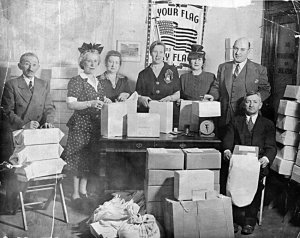 The exhibit tells how the Jews of Michigan supported the war. America’s participation was a wonderful thing. Helping the European Jews was what we should all be doing. Jews like young Harriet Fields collected 381,000 pounds of household waste fat! The Federation of Polish Jews in Detroit [shown right, publicizing their war service] sent packages to the men and women of the Armed Services. The Jewish-owned Paramount Coffee Company of Lansing sent out New Year’s Greeting flyers about the importance of helping one another (without mentioning the war at all, though). The Temple Beth El Bulletin encouraged people to buy war bonds!
The exhibit tells how the Jews of Michigan supported the war. America’s participation was a wonderful thing. Helping the European Jews was what we should all be doing. Jews like young Harriet Fields collected 381,000 pounds of household waste fat! The Federation of Polish Jews in Detroit [shown right, publicizing their war service] sent packages to the men and women of the Armed Services. The Jewish-owned Paramount Coffee Company of Lansing sent out New Year’s Greeting flyers about the importance of helping one another (without mentioning the war at all, though). The Temple Beth El Bulletin encouraged people to buy war bonds!
Jewish organizations made sure they offered social and spiritual support for specifically Jewish soldiers. Beginning in 1942, Jews began protesting a “Nazi Holocaust” of European Jews in Detroit newspapers and in public meetings. The exhibit shows pictures of two whole Michigan Jews who had fallen … they are portrayed as heroes. And it doesn’t leave out that America did not want to take in all of Europe’s Jewish refugees who wanted to come here. It points out everything that the Jews did to help other Jews, and how they got non-Jews to help Jews too.
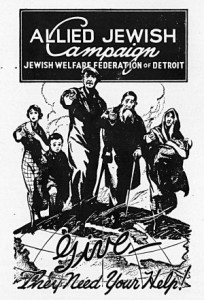 The Allied Jewish Campaign raised money to help Jews. Wow, what sacrifice! “Between 1932 and 1940, its theme shifted from taking care of the needy Jews in the United States to supporting rescue and survival of Jews abroad.” It’s fundraising goal rose from $165,000 to $925,000. Guess who they got most of the money from?
The Allied Jewish Campaign raised money to help Jews. Wow, what sacrifice! “Between 1932 and 1940, its theme shifted from taking care of the needy Jews in the United States to supporting rescue and survival of Jews abroad.” It’s fundraising goal rose from $165,000 to $925,000. Guess who they got most of the money from?
And, of course, “Michigan Jews, especially in Detroit, were active on behalf of building a Jewish homeland in Palestine.” Finally, the stories of four Jewish children who came to the U.S as refugees and are such treasures. Then, MSU’s Jeanette Abeles , Ken Waltzer and Michael Seadle tell stories, with pictures, of their Jewish family history, though none were connected with Michigan. Have we heard enough about Jews yet?
From whence the money comes
This traveling exhibition was made possible with financial support from Congregation Shaarey Zedek of East Lansing, Michigan State University Jewish Studies Program (that’s Waltzer’s domain), Michigan State University Museum, the Michigan Humanities Council, the Ben Teitle Foundation, the Michigan Council for Arts and Cultural Affairs and private donors.
For a fee of $800, plus shipping, the exhibition has been displayed at the following sites so far (according to the website): Northern Michigan University, Marquette, MI; Macomb Community College, Clinton Twp, MI; and Kalamazoo Valley Museum, Kalamazoo, MI.
This “anti-anti-Semitism” project extolling the virtues of Jews is what Ken Waltzer has kept himself busy with in 2013, instead of finishing his book on the children of Buchenwald. What will he come up with next? It’s been clear for some time that the main guiding force for Waltzer is the promotion of Jewry, in whatever way best achieves that goal. Holocaustianity is certainly one way. Heading a Jewish Studies program at a university is another. Working in conjunction with the U.S. Holocaust Memorial Museum is another. And certainly, protecting and promoting the image of Elie Wiesel is also one.
It’s possible, however, that he’s run into a brick wall on Elie Wiesel.
Endnotes:
1. Waltzer admittedly relies on survivor testimony – the least dependable form of “evidence.” In this 2011-2012 Q-A session linked to above, he says:
… my own book, Telling the Story: The Rescue of Children at Buchenwald, will be finished in about a year and will tell the story in much greater detail and more attention to complexity, drawing on information obtained from nearly 200 of those who were helped to survive at the Nazi camp. It will say more about who these boys were, what their experiences were both before Buchenwald and then inside Buchenwald, and where they went and what they did with their memory of experience after liberation. A second book, to be prepared thereafter, will be called Children’s Stories, and will pull together many distinctive stories I’ve been told or have encountered while working on the collective story.
Note that Waltzer is “telling a story” that has been told to him by old men about what happened to them as children. Realize what “story” means to Jews – one is freed from all necessity of accurate fact.
8 Comments
Category Featured | Tags: Tags: Allied Jewish Campaign, anti-Semitism, Charles Coughlin, Hank Greenberg, Jeanette Abeles, Jewish homeland in Palestine, Ken Waltzer, Lauren Bacall, Michael Seadle, Michigan State University,
Social Networks: Facebook, Twitter, Google Bookmarks, del.icio.us, StumbleUpon, Digg, Reddit, Posterous.
Saturday, June 29th, 2013
By Carolyn Yeager
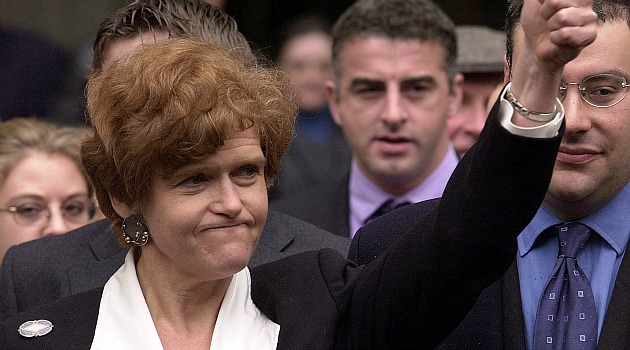
Deborah Lipstadt slammed leaders of the Claims Conference on June 26, 2013. (Getty Images)
Prof. Kenneth Waltzer used to be the man to go to when the press wanted to know what to think about any “holocaust” scandal. An example is the book, that was ready to be made into a movie, by Herman and Roma Rosenblat, Angel at the Fence. Waltzer gained a lot from his role in debunking the story (even though it was easy to do), receiving attention in the press as an “honest holocaust historian. “
Waltzer teaches German history at Michigan State University and is also director of its Jewish Studies Program since 1992 (with some time off).
When he was interviewed by Harper’s magazine about the Rosenblat fraud in December 2008, it boosted his reputation and standing. But for some time now, the only one getting the media attention is Deborah Lipstadt, professor of Jewish Studies at Emory University. I have not seen a word written, nor any kind of announcement from Waltzer about his main project for months. He spent 2011-2012 as the Winegarden Visiting Professor at UM-Flint during which time he worked with students creating their own papers to add to the overabundance of holocaust lore & trivia already in existence. [An interesting sidelight is that his students were directed to use “testimonies and memoirs” as primary sources, and “books and articles” as secondary sources. There is obviously no need for original documents in Prof. Waltzer’s classes.]
I have been scrutinizing Waltzer on the pages of Elie Wiesel Cons The World (EWCTW), not only for mistakes in his holocaust historical account, but also for deception and cover-ups. Can it be that, from this, Ken Waltzer has come to be seen as more of a liability than an asset to other holocaust historians? I can only say it is possible, and Deborah Lipstadt is one who would make such a determination faster than many others. Lipstadt is like a pitbull when it comes to fighting to keep her Jewish Holo Legend afloat; like a hound dog when it comes to sniffing out dangers to it.
Could it be that she has smelled a bad odor coming from Waltzer’s repeated screw-ups as revealed right here at EWCTW, and perhaps has even had a private “scholar to scholar” meeting with him?
Imagined Scenario
“You’re going on the sidelines, Kenny, and I will take over. I don’t want to hear a peep from you until I can assess things and come up with the way forward. Because of your stupid “Rescue of the Children of Buchenwald,” Elie may now be damaged beyond repair … and even he is not more important than preserving the integrity of our sacred Holocaust narrative. If Elie Wiesel is not more important – then you, Ken Waltzer, are certainly not!”
Lipstadt’s special relationship with the Claims Conference
In any event, Lipstadt has taken it upon herself to go after the Jewish Claims Conference officials who handed out hundreds of millions of dollars of German taxpayers’ money to fake holo survivors for 8 years before they “discovered” in 2009 what they had been warned about in 2001.
You can read about her reaction here. The failure on the part of the Claims Conference is certainly bad, but my concern here is more with why Waltzer has nothing to say about it, or why news reporters are not seeking his remarks on Lipstadt’s comments. Has Kenny been put in the dog house?
Lipstadt has come out slugging as the “honest holocaust historian” on a new “Jewish Facebook” page on June 26. She is listed as a poster on this page, along with Rabbi David Wolpe.
She wrote dismissively of the Claims Conference, saying that “No one will resign. No one will admit that they screwed up… big time.” This informs us that in spite of her show of outrage, she considers it just a screw-up … not a crime! (Jews don’t commit crimes.)
But still and all, she remains a “great fan” because of the CC support of survivors and historians. Historians?
Lipstadt said the Claims Conference funded the translation of portions of her website, Holocaust Denial on Trial, into Arabic, Farsi, Russian, and Turkish. “I remain tremendously grateful to The Claims Conference for this and other important educational and humanitarian work it has done,” Lipstadt said.
So the Claims Conference, that was instituted to provide a lifetime allowance for “holocaust survivors” who allegedly meet the requirements, also gives German taxpayer money to historians for their websites on which they promote a pro-holocaust narrative and belief. And attack those who are skeptical about it, as Lipstadt does on her “Holocaust Denial on Trial” website.
Is the Claims Conference to be a supporter of pro-holocaust propaganda, or is it to be the administrative arm for determining who is an eligible survivor? It seems to me that Deborah Lipstadt is as guilty of mishandling these funds as anyone! However, on the Claims Conference web site on the “What We Do” page we find:
We fund social services that assist elderly, needy Nazi victims, and allocate limited funds to support Holocaust education, documentation and research.
They have snuck those words into the third item of the four, after the part about funding social services for elderly, needy victims. If it’s legitimate, why do they have to sneak it? Why not make it an item of it’s own.
Lipstadt’s relationship with Ken Waltzer
On Dec. 28, 2008, Deborah Lipstadt wrote this on her blog about Waltzer’s work:
“Professor Ken Waltzer, who did the research that essentially confirmed that Herman Rosenblatt’s memoir was fabricated, has issued the following statement. It is exceptional in its sensitivity and its focus on the real culprits in this entire messy saga.
I have learned tonight that Penguin Berkley Press has pulled the memoir, Angel at the Fence, which I and others have been investigating, from publication. Herman Rosenblat has shared the news that he invented the false story with Harris Salomon, president of Atlantic Overseas Pictures, and Harris Salomon has told the publisher. Penguin Berkley Press will seek restitution. [The second sentence is awkwardly written, something that is common in Waltzer’s writing, showing he was not well educated before his admission to the graduate History program at Harvard. You decide for yourself how he got in. -cy]
I am saddened by the whole thing. First, Herman and Roma Rosenblat are of course to be faulted for making up a Holocaust love story and seeking fame and public attention, but their lying and dissimulating are actually understandable. Less understandable is the widespread belief in their story by the culture makers, including the publisher and movie maker and many thousands of others who have encountered it over a decade.
Second, such belief suggests a broad illiteracy about the Holocaust and about experience in the camps — despite decades of books, serious memoirs, museums, and movies. This shakes this historian up.
This memoir was at the far end of implausibility, yet until yesterday, no one connected with packaging, promoting, and disseminating it asked question about or investigated it. It is same with Elie Wiesel, exactly! Some actively resisted such investigation and tried to shut mine down. [Yes, indeed, investigation into Elie Wiesel’s Night is just as necessary as into the Rosenblat story.-cy]
The idea of a prisoner autonomously going to the fence daily, every day, in a Nazi concentration camp and meeting a young girl at the guarded, electrified fence who was allegedly hiding under false identity with her family in the nearby village and who threw him food beggars the imagination. Prisoners in konzentrationslager could not approach guarded fences; persons in hiding with a primary family group would not risk detection by going daily to a camp where SS guards were concentrated. The actual fence in Schlieben was right next to the SS barracks.
So Herman and Roma overreached and actually demeaned their own Holocaust stories — Herman forgot his brothers who kept him alive in the camps, Roma forgot her own remarkable and sad family story hiding not in Schlieben but elsewhere more than 200 miles away.
But where were the culture makers on this one? What kind of questions did Penguin Berkley Press bring to bear regarding a memoir about a love story set in a concentration camp? What kind of strategy did Harris Salomon embrace to elevate a candy coated Holocaust love story to bring Holocaust education to Middle America? This was not Holocaust education but miseducation. Holocaust experience is not heartwarming, it is heart rending. All this shows something about the broad unwillingness in our culture to confront the difficult knowledge of the Holocaust. All the more important then to have real memoirs that tell of real experience in the camps. [But real memoirs are called Holocaust Denial by D. Lipstadt! -cy]
I want to thank those who have worked with me – particularly forensic genealogists Sharon Sergeant and Colleen Fitzpatrick, and amateur Schlieben historian Uwe Schwarz and his associate Jean-Luis Rey. I also want to thank the many survivors, including Ben Helfgott and Sid Finkel, who put their trust in me and shared their knowledge. Gabe Sherman’s reportage at the New Republic has been remarkable, and there will be more to say in the coming days. [See all the help he needs! LOL -cy]
Ken Waltzer
Director, Jewish Studies
Michigan State University
Finally, a podcast produced by Lipstadt’s denial website:
It carries no date, but would be from 2008-09, or early 2010 at the latest! The interviewer’s name was Leshem.
Q. [Leshem]
Finally, finally, can you just tell us what the title of your forthcoming book is and when we might expect it?
A. [Waltzer]
Well, I’ve got probably another year of writing to go. [At that time! So what happened? Give an explanation please. Where is the book?] The current title is The Rescue of Children and Youths at Buchenwald, and it tells the story of the communist-led underground in the camp who in ’43 and ’44 evolved a response to the rise of young children and youths inside Buchenwald. They tried to protect them; they tried to increase the likelihood or probability that they would endure until the end of the war. They did it in an ad-hoc (very specific) way because they didn’t have control of the transports and they didn’t know who, or what number, would be coming. And initially they didn’t save very many. Many were sent to the outlying camps and died doing harsh work. [How does he know?] But from summer of ’44 on, against the backdrop of the Allies coming closer from both East and West, which the underground knew about, the underground kept large numbers of boys inside the camp, kept them from being sent out to the outlying sub camps, sheltered them in barracks under underground control — a kind of tough love disciplined control — and gave them access to extra clothing and food, and even in a couple of cases in some barracks conducted schools that lifted their minds beyond the everyday nastiness of the camp. [This all comes from testimony – not under oath – of communists, jews, and communist Jews, not from records. Furthermore, it would not have been possible, and also was not necessary.]
And as a consequence, that helps answer the question how it is that there were 904 boys alive to be liberated when Patton’s army showed up. They had been nurtured, protected, and helped to be made safe by older men, including Communists from Germany, Czechoslovakia, and Hungary, and a Polish-Jewish element that worked with the underground to help save the boys. [You see how they have to credit themselves for the survival of youngsters because it doesn’t fit their overall extermination narrative. Yet, the youth were looked after because the German camp administration saw to it that they were looked after. Following the “liberations,” all the German personnel were killed or arrested or were forced to flee, thus the “victims” could tell any story they wished. If there were any honest ones, they were soon silenced. -cy]
2 Comments
Category Featured | Tags: Tags: Deborah Lipstadt, Emory University, Herman and Roma Rosenblat, holocaust memoirs, Jewish Claims Conference, Jewish Facebook Page, Michigan State University,
Social Networks: Facebook, Twitter, Google Bookmarks, del.icio.us, StumbleUpon, Digg, Reddit, Posterous.
Monday, April 1st, 2013
By Carolyn Yeager
copyright 2013 Carolyn Yeager
Updated April 7th
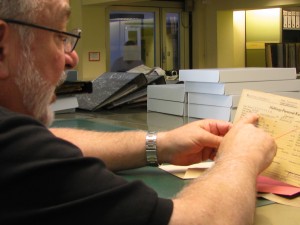
Prof. Kenneth Waltzer is looking at a Buchenwald registration card at the International Tracing Service in Bad Arolsen, Germany.
Kenneth Waltzer is a professor of history at Michigan State University since the early 1970’s. He helped to create the Jewish Studies program which opened in 1992, and which he heads. Waltzer has been researching into evidence of a special ‘boy’s protection program’ run by prisoners at Buchenwald for going on 10 years now. As an “approved” researcher, he is allowed to peruse all the files at the International Tracing Service in Bad Arolsen, Germany, something that is made much more difficult, if not impossible, for revisionists.
Waltzer is considered one of the top scholars in the U.S. of the ill-named holocaust but his work has been sloppy, and his attempts to cover up the sloppiness amount to fraud. This, along with his continual promotion and defense of Elie Wiesel as a Buchenwald survivor, is what has drawn me to study him ever more closely.
Because of the seriousness of the charge I am making against him, I will list right up front my reasons for thinking it is time for such a call. They are:
- Waltzer habitually tells fibs in the form of false information which is intended to mislead. When called out for it, he tells more fibs to cover for the first ones.
- He has been in the service of the “Holocaust Industry,” not academic rigor and fair-mindedness, from the very start of his career.
- He knowingly defrauds his students, his university and the public (you and I) with his dishonest “holocaust scholarship.”
- While he is drawing high pay as a tenured American professor of history at MSU, he is working to advance the State of Israel.
I am going to show that these charges have a strong basis in fact. Fraud is commonly understood as dishonesty calculated for advantage. A person who is dishonest may be called a fraud. In the U.S. legal system, fraud is a specific offense with certain features. (see here)
Legally, fraud must be proved by showing that the defendant’s actions involved five separate elements: (1) a false statement of a material fact, (2) knowledge on the part of the defendant that the statement is untrue, (3) intent on the part of the defendant to deceive the alleged victim, (4) justifiable reliance by the alleged victim on the statement, and (5) injury to the alleged victim as a result.
I am not intending to bring legal charges of fraud against Prof. Waltzer, but to try him in the court of public opinion. Therefore, it will be up to Waltzer to defend himself against my charges.
* * *
Two years ago, I asked the question on this web site: “What happened to Ken Waltzer’s book about the boys of Buchenwald?” It was claimed to be, at that time, in it’s final stages. Eight years after he publicly announced he was researching for a book about the so-called children’s barracks at Buchenwald (Barracks #66 ), it still has not materialized. Five years after his book was described as “upcoming,” it still has not materialized. During this time, he has not produced another book, or any major work that would have taken precedence over this book. So what is the delay?
It’s pretty plain that the book’s thesis has shifted considerably since 2005, when his MSU website featured Elie Wiesel as the most recognizable and famous child survivor from Buchenwald. That website was taken down between one and two years ago and is completely wiped clean from the Internet. The banner on all the six to eight pages that were included showed a photograph very similar to the one below of the “boys” being marched out of the main Buchenwald camp to temporary quarters at the former SS barracks.
The USHMM (national holocaust museum in D.C) website dates this picture as being taken on April 17, 1945, six days after liberation.1 At this time, Elie Wiesel, by his own account in two books, was laying in a hospital sick almost unto death from food poisoning. Details like this don’t deter Prof. Waltzer from backing up in every instance the standard holocaust narrative. “Elie Wiesel in Buchenwald” is the standard narrative, so evidence must be found for it.
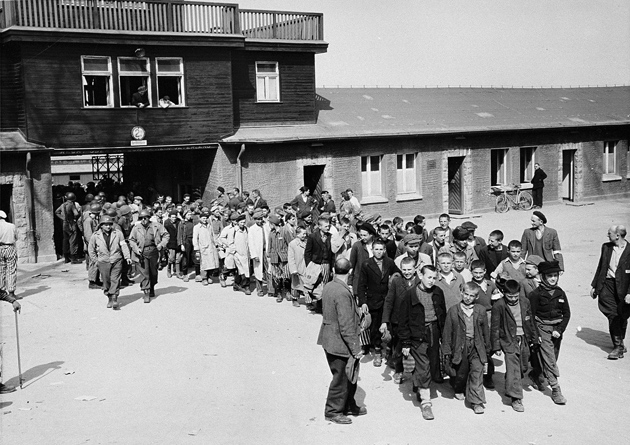 Ken Waltzer claimed for years that one of these boys was Elie Wiesel. But Wiesel is not in this picture!
Ken Waltzer claimed for years that one of these boys was Elie Wiesel. But Wiesel is not in this picture!
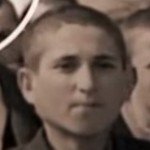 From at least 2005 (eight years now), Waltzer has identified the boy third from the front in the left-side column (dressed in a black suit, bareheaded, and in front of the tall boy wearing a beret) as Elie Wiesel, based on nothing but his own fraudulent intention that there was enough resemblance that people would believe it if he said so. In this article , I exposed this lie. Waltzer has never admitted that he was mistaken or was perpetrating a falsehood that he intended to put into his book. Instead, what he did when his fabrication was sufficiently exposed was to take the entire site down and not mention it again.
From at least 2005 (eight years now), Waltzer has identified the boy third from the front in the left-side column (dressed in a black suit, bareheaded, and in front of the tall boy wearing a beret) as Elie Wiesel, based on nothing but his own fraudulent intention that there was enough resemblance that people would believe it if he said so. In this article , I exposed this lie. Waltzer has never admitted that he was mistaken or was perpetrating a falsehood that he intended to put into his book. Instead, what he did when his fabrication was sufficiently exposed was to take the entire site down and not mention it again.
Left is a close-up of the boy Waltzer has maintained for several years is Elie Wiesel. Anyone can tell it is not and that’s why no one else ever publicly agreed with him.
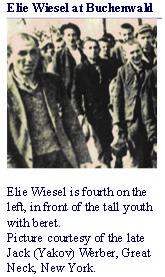 I have some of what was on that site copied into articles here at EWCTW and also in my files. At left is the cropped section of the photo that Waltzer used on the banner of his MSU-Newsroom/Holocaust website that was very much dedicated to Elie Wiesel. (Another reader, Chris, informed me that he had found pages from the site using the Way Back Machine. Many thanks to him.) This shows that Waltzer definitely identified the boy in the black suit as Elie Wiesel. In addition, Jack Werber, a known dishonest survivor, was the supposed supplier of the picture.
I have some of what was on that site copied into articles here at EWCTW and also in my files. At left is the cropped section of the photo that Waltzer used on the banner of his MSU-Newsroom/Holocaust website that was very much dedicated to Elie Wiesel. (Another reader, Chris, informed me that he had found pages from the site using the Way Back Machine. Many thanks to him.) This shows that Waltzer definitely identified the boy in the black suit as Elie Wiesel. In addition, Jack Werber, a known dishonest survivor, was the supposed supplier of the picture.
Below right, a screen shot of one of the pages as it existed then, sent by a friend of EWCTW. It shows more of the emphasis on Elie Wiesel.
When I pointed out much of this in a podcast of March 25th, Waltzer sent me an email on March 28th stating,
My websites at UM FLint are down because I was appointed there one year and am now back at Michigan State.
Of course I never mentioned UM Flint and never even saw his website there. I was speaking about his MSU website, which was titled something like Ken Waltzer’s “MSU Newsroom Special Report.” It was full of information about his projects and especially what he calls “the rescue operation of children at Buchenwald.” It was up on the Net since at least 2008 2, then suddenly disappeared, with not even cache pages to be found. Did Waltzer tell me a fib, or did he just read the podcast program description and misinterpret what it said about “taking down web pages?” By now, he will know what I mean and may answer.
 I think it is very possible that he timed the take-down of his MSU “Newsroom” site with his one-year visiting professorship at UM Flint — putting up a temporary website there which he could take down when he left. This is a way of confusing the picture in order to distract as much as possible from his more recent decision to put more distance between himself and his prior (false) assertions about Elie Wiesel.
I think it is very possible that he timed the take-down of his MSU “Newsroom” site with his one-year visiting professorship at UM Flint — putting up a temporary website there which he could take down when he left. This is a way of confusing the picture in order to distract as much as possible from his more recent decision to put more distance between himself and his prior (false) assertions about Elie Wiesel.
His intention was and is clearly to deceive. The harm is caused to ordinary people who believe and trust that they are getting knowledgeable answers from a professor of history and a holocaust scholar. In this particular case, all five of the elements necessary to prove fraud are there.
First, he sets up a University-sponsored website maintaining falsely that Elie Wiesel is the boy in the photograph of youthful “survivors” marching out of the camp (1). He knows it is false because he has no evidence or proof, only his own “wishful thinking.” The USHMM never identified Wiesel in that group of boys, nor did anyone else (including Wiesel himself), unless they did so from following Waltzer’s example (2). Waltzer’s intent was to make the public believe something that was not true – that he had proof of Elie Wiesel being one of the “rescued children” (3). Because Waltzer is a Professor of History and “holocaust expert” at a major university, and is at all times written up very favorably in the media, the public (you and I ) and his students will rely on his statements (4). These same students and public are injured when photographs are mislabled in order to foist on them a certain belief about an influential historical event that affects their entire world view (5).
* * *
This is just one instance of the untruths that Ken Waltzer has told over the years. Another tactic he uses is to promise an upcoming answer to your doubts which he cannot or does not produce now. As we have seen, we continue to wait as he continues to promise. Still another tactic is to accuse others of lying when it is he who is doing so. But only people who are knowledgeable enough about these complex and purposely obscured issues can see who is doing the lying. In this same email, Waltzer wrote:
The book is on track, and I have also completed a separate essay to be published on Elie Wiesel and Buchenwald.
Completed, he says. And separate. Why separate? I wrote back to him asking where I could find his essay because I wanted to read it. No reply – which is typical because factual information is not his forte, emotional rhetoric is. I feel it’s quite possible, even probable, he wrote a separate essay on Elie Wiesel so as not to tarnish his book with the false “facts” about Wiesel in Buchenwald. He can always get rid of an essay, if necessary, later – but not his entire book. What might there be in this essay? [As it turned out, the book never manifested at all –cy, 4-14-25] Will it be the same or quite different from what he wrote in a March 6, 2010 comment at Scrapbookpages Blog, when he said [my underlining-cy]:
For the skeptics [I was using the screen name “skeptic” then, at Scrapbook blog -cy] and know-nothings who have written in suggesting Eli Wiesel was not in the camps, that Night is purely fiction, you are all dead wrong. The Red Cross International Tracing Service Archives documents for Lazar Wiesel and his father prove beyond any doubt that Lazar and his father arrived from Buna to Buchenwald January 26, 1945, that his father soon died a few days later, and that Lazar Wiesel was then moved to block 66, the children’s block in the little camp in Buchenwald. THese documents are backed up by military interviews with others from Sighet who were also in block 66, and by the list of Buchenwald boys sent thereafter to France. All of this is public domain.
Wishful thinking by Holocaust deniers will not make their fantasies true. While Wiesel took liberties in writing Night as a literary masterpiece, Night is rooted in the foundation of Wiesel’s experience in the camps. The Buchenwald experience, particularly, runs closely to what is related in Night.
Comment by kenwaltzer — November 14, 2010 @ 6:57 am
How much untruth is contained in this, in order to defraud us all in his devoted service to the “Holocaust Industry” and the state of Israel? Plenty. As proof that Elie Wiesel was in Buchenwald, he points to documents for Lazar Wiesel and “his father.” It is even more absurd because Lazar Wiesel’s relative was only 13 years older than Lazar – it was in fact his brother Abram! Waltzer is passing off Lazar for Elie simply on the basis that Lazar also came from Sighet, Elie’s hometown and carries the same name. Sighet was a city of 50,000 or so with a very large Jewish population, and Wiesel was a common name. But the “scholar” who has taken years to research this and still isn’t finished, wants us to believe there can be only one Lazar Wiesel, who is Elie. He attributes the difference in their birthdates to bureaucratic error.
Previously I may have called this stupidity, but now I’m calling it fraud, based on the above-given definition. Of course Waltzer can see the discrepancies here, but he hopes he can convince you not to see them. The Military Interview mentioned with Lázár Wiesel’s name on it also does not have the right birthdate for Elie Wiesel, nor does the signature match Elie’s well-known signature.
Will Waltzer repeat this nonsense in his latest “completed” essay? Notice that Waltzer never fails in the name-calling department, here calling his critics names such as “know-nothings” and “Holocaust deniers.” Several months later, he wrote a similar comment at EWCTW to the blockbuster article: “Signatures Prove Lázár Wiesel is not Elie Wiesel”
by kenwaltzer
On November 14, 2010 at 10:34 am
Contrary to Carolyn Yeager’s wishful thinking, Eli Wiesel was indeed the Lazar Wiesel who was admitted to Buchenwald on January 26, 1945, who was subsequently shifted to block 66, and who was interviewed by military authorities before being permitted to leave Buchenwald to go with other Buchenwald orphans to France. Furthermore, there is not a shadow of a doubt about this, although the Buchenwald records do erroneously contain — on some pieces — the birth date of 1913 rather than 1928. A forthcoming paper resolves the “riddle of Lazar” and indicates that Miklos Gruner’s Stolen Identity is a set of false charges and attack on Wiesel without any foundation.
The promise of a forthcoming paper turned out to be a fib. From Nov. 2010 to now, there has not been any paper. Maybe it’s the essay he mentioned in his March 28th email? “Forthcoming” to Waltzer means up to two and a half years, it seems. That in itself is the sign of an unreliable person.
There can be only one reason Ken Waltzer allows himself to look like a buffoon and a shyster. He doesn’t need to do it to keep his position at Michigan State University. He does it because it is his larger job to keep the Buchenwald atrocity stories and Liberation lies, including the Elie Wiesel myth, alive and well in the mind of the public. He works for purely Jewish interests – I will be writing a future article on the priority, meaning and funding of Jewish Studies programs in American universities. For now, I can add that Waltzer is more of a public relations (PR) worker for the Holocaust Industry, the State of Israel and maybe AIPAC, than he is an honest-to-god academic. Another organization connected to Israel that he serves is Scholars for Peace in the Middle East. He has written four attack-dog articles for them since 2009, functioning in a sort of Abe Foxman-pitbull style.
In Nov. 2009, he attacked Alison Wier as another “know-nothing” because she speaks up for Palestinian rights on college campuses, where she is popular.
In May 2010, he went after John Mearsheimer for calling Israel “an apartheid state” and also took out after Noam Chomsky, Norman Finkelstein, and “the crackpot Phil Weiss.”
Also in May 2010, another target was Judith Butler, who campaigned at the Berkeley campus for the university “to divest from companies making military weapons which Israel employs to commit war crimes.”
In August 2011, he wrote on the Israeli-Palestinian peace process, arguing for Israel’s interests to be well and strongly presented on college campuses.
But this is only the tip of the iceberg when it comes to Walzer’s pro-Israel activities. I will be writing further articles that present the evidence for Ken Waltzer being guilty of fraud in his public writings and during his entire career. Much of it revolves around Elie Wiesel and the Industry’s need to place him at Buchenwald. My position, if you have somehow missed it, is that Elie Wiesel was never at Buchenwald. I am also saying that Waltzer is backing down or “stepping back” from his blatant, dishonest claims about Wiesel, but he can’t back down altogether.
Endnotes:
1. I have also seen it dated April 27 at the USHMM and have used that date in other articles here. Now I have only found this one picture which is very officially dated the 17th. There may have been an attempt to move the date to the 27th so that Wiesel could be in the picture (though he supposedly would not have been released from the hospital until the 28th). It is really too bad the USHMM cannot be relied upon; nor can Yad Vashem. When the museum “researchers” are involved in lying or in complacency, one really has nowhere to turn.
2. http://msutoday.msu.edu/news/2008/mapping-the-holocaust-archive-msu-prof-explores-records-of-nazi-atrocities At bottom of article, it reads “For more information, and to follow Waltzer’s research and read his journal as he participates in the workshop, visit the special report at: http://special.newsroom.msu.edu/holocaust.” This is a link to the website that no longer exists, as you will see if you click it. Now he seems to be pretending it was never there.
11 Comments
Category Featured | Tags: Tags: Abram Vizel, Buchenwald camp, Buchenwald liberation, Elie Wiesel, Holocaust Industry, Israel, Ken Waltzer, Lazar Wiesel, legal definition of fraud, M. Grüner, Michigan State University, Night, Scholars for Peace in the MIddle East, USHMM,
Social Networks: Facebook, Twitter, Google Bookmarks, del.icio.us, StumbleUpon, Digg, Reddit, Posterous.
Tuesday, June 14th, 2011
by Carolyn Yeager
MSU Prof. Kenneth Waltzer has been promising his book The Rescue of Children and Youth in Buchenwald since 2007. Four years later, he’s being very quiet about it.
Here is a timeline of announcements about this work in progress, all taken from his Michigan State University website.
May 2005: Professor Waltzer presented a paper, “The Rescue of Children at Buchenwald: Behavior in a Grey Area,” at the Midwest Jewish Studies Scholars Colloquium, Cohn-Haddow Judaic Studies Program, Wayne State University, Detroit.
March 2007: Ken Waltzer will present a paper on “The Kovno Boys: Survival at Auschwitz, Buchenwald, and Mauthaussen,” at the 37th Annual Holocaust Scholars Conference in Cleveland, Ohio.
April 2007: Ken Waltzer presents on his book-in-progress, The Rescue of Children and Youth in Buchenwald, at James Madison College.
May 2008: MSU Professor Ken Waltzer gave the Monna and Otto Weinmann Lecture at the U.S. Holocaust Memorial Museum on the subject of his upcoming book on the rescue operation at Buchenwald that he said saved the lives of hundreds of children and youths.
April 2010: Kenneth Waltzer, professor of history and director of the Jewish studies program at Michigan State University, is currently completing a book about the rescue of children and youths at Buchenwald. [From the April 16, 2010 The Jewish Daily Forward]
The Elie Wiesel Problem
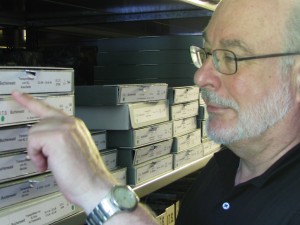 Prof. Waltzer has written and shown pictures of himself (right) doing research at Bad Arolson in Germany, seeking to discover details about the lives and families of the boys of Buchenwald. One of the boys that he may be having trouble with is Elie Wiesel. Waltzer has made a lot of claims and put himself on the line about Wiesel that, in this writer’s opinion, cannot be substantiated.
Prof. Waltzer has written and shown pictures of himself (right) doing research at Bad Arolson in Germany, seeking to discover details about the lives and families of the boys of Buchenwald. One of the boys that he may be having trouble with is Elie Wiesel. Waltzer has made a lot of claims and put himself on the line about Wiesel that, in this writer’s opinion, cannot be substantiated.
For example, last November Waltzer commented on this website to my article “Signatures Prove Lázár Wiesel is not Elie Wiesel” with the following:
Contrary to Carolyn Yeager’s wishful thinking, Eli Wiesel was indeed the Lazar Wiesel who was admitted to Buchenwald on January 26, 1945, who was subsequently shifted to block 66, and who was interviewed by military authorities before being permitted to leave Buchenwald to go with other Buchenwald orphans to France. Furthermore, there is not a shadow of a doubt about this, although the Buchenwald records do erroneously contain — on some pieces — the birth date of 1913 rather than 1928. A forthcoming paper resolves the “riddle of Lazar” and indicates that Miklos Gruner’s Stolen Identity is a set of false charges and attack on Wiesel without any foundation. ~~ by kenwaltzer on November 14, 2010 at 10:34 am
The birthdate on Lazar Wiesel’s records is erroneous—that’s his answer? He is going to “resolve” that? The “forthcoming paper” has not yet appeared 7 months later. His website pages have not been updated for awhile; in fact, they look downright dormant.
Here are the problems I think Waltzer is having, in addition to the birthdate problem:
- He has claimed for at least several years that a picture he has placed on his website of the boys walking out of the Buchenwald front gate shows Elie Wiesel “toward the left.” [See The Many Faces of Elie Wiesel] I say it is not Elie Wiesel, and I don’t know anyone but Waltzer who has identified this boy as Elie Wiesel. This picture is also shown on the USHMM website, and they make no mention of Elie Wiesel as one of the boys.
- In a Power Point presentation that is available on his website, Waltzer shows a group picture of the ‘religious boys’ out of those who went to France, that he says includes Elie Wiesel. I have studied this picture closely and do not see anyone who resembles Wiesel. If Waltzer knows that Elie Wiesel is in the picture, why doesn’t he identify him with an arrow?
Famous Buchenwald Liberation photo is another problem
As I pointed out in “The Many Faces of Elie Wiesel,” the pictures that Waltzer claims contain the face and person of Elie Wiesel do not resemble each other. The famous barracks photo which the New York Times declared to be Elie Wiesel as a 16-year old Buchenwald inmate—and is reproduced all over the world as Elie Wiesel—doesn’t look like the other 16-year old faces.
This writer suspects that Ken Waltzer is having difficulty convincingly incorporating Elie Wiesel into the story of the “boys of Buchenwald” and their rescue. He has been a friend and devotee of Wiesel for many years, they are both strongly associated with the U.S. Holocaust Memorial Museum, and Wiesel has been a part of his Buchenwald story from the beginning. But the real evidence for Elie Wiesel ever being an inmate at Buchenwald doesn’t exist. There are no photographs of Elie Wiesel at Buchenwald; there are no photos of Wiesel during his supposed one-year concentration camp period at all.
I think Waltzer believed this slipshod approach he employs would pass without comment, but he didn’t count on the appearance of Elie Wiesel Cons the World website. We are a real problem for Ken Waltzer!
10 Comments
Category Featured | Tags: Tags: Bad Arolson, Boys from Buchenwald, Elie Wiesel, Kenneth Waltzer, Michigan State University, New York Times, USHMM,
Social Networks: Facebook, Twitter, Google Bookmarks, del.icio.us, StumbleUpon, Digg, Reddit, Posterous.
 What is learned from the exhibition
What is learned from the exhibition  The main thing I notice about this exhibit is that it is totally, 100% about Jews and specifically Jewish concerns. The few non-Jews mentioned are enemies of the Jews. While it starts out saying that by the 1930’s Jews were increasingly comfortable with American ways, it shows nothing about Jews integrating socially with American gentiles and Christians, but only sticking closely with their own kind, their own organizations, their synagogues and businesses. Jews want to be accepted by the majority Gentile culture as “just like them,” but they do not want to participate in the majority Gentile culture, except politically and financially. [Left: Bar Mitzveh Day for Harry Klein]
The main thing I notice about this exhibit is that it is totally, 100% about Jews and specifically Jewish concerns. The few non-Jews mentioned are enemies of the Jews. While it starts out saying that by the 1930’s Jews were increasingly comfortable with American ways, it shows nothing about Jews integrating socially with American gentiles and Christians, but only sticking closely with their own kind, their own organizations, their synagogues and businesses. Jews want to be accepted by the majority Gentile culture as “just like them,” but they do not want to participate in the majority Gentile culture, except politically and financially. [Left: Bar Mitzveh Day for Harry Klein] The exhibit tells how the Jews of Michigan supported the war. America’s participation was a wonderful thing. Helping the European Jews was what we should all be doing. Jews like young Harriet Fields collected 381,000 pounds of household waste fat! The Federation of Polish Jews in Detroit [shown right, publicizing their war service] sent packages to the men and women of the Armed Services. The Jewish-owned Paramount Coffee Company of Lansing sent out New Year’s Greeting flyers about the importance of helping one another (without mentioning the war at all, though). The Temple Beth El Bulletin encouraged people to buy war bonds!
The exhibit tells how the Jews of Michigan supported the war. America’s participation was a wonderful thing. Helping the European Jews was what we should all be doing. Jews like young Harriet Fields collected 381,000 pounds of household waste fat! The Federation of Polish Jews in Detroit [shown right, publicizing their war service] sent packages to the men and women of the Armed Services. The Jewish-owned Paramount Coffee Company of Lansing sent out New Year’s Greeting flyers about the importance of helping one another (without mentioning the war at all, though). The Temple Beth El Bulletin encouraged people to buy war bonds! The Allied Jewish Campaign raised money to help Jews. Wow, what sacrifice! “Between 1932 and 1940, its theme shifted from taking care of the needy Jews in the United States to supporting rescue and survival of Jews abroad.” It’s fundraising goal rose from $165,000 to $925,000. Guess who they got most of the money from?
The Allied Jewish Campaign raised money to help Jews. Wow, what sacrifice! “Between 1932 and 1940, its theme shifted from taking care of the needy Jews in the United States to supporting rescue and survival of Jews abroad.” It’s fundraising goal rose from $165,000 to $925,000. Guess who they got most of the money from?










